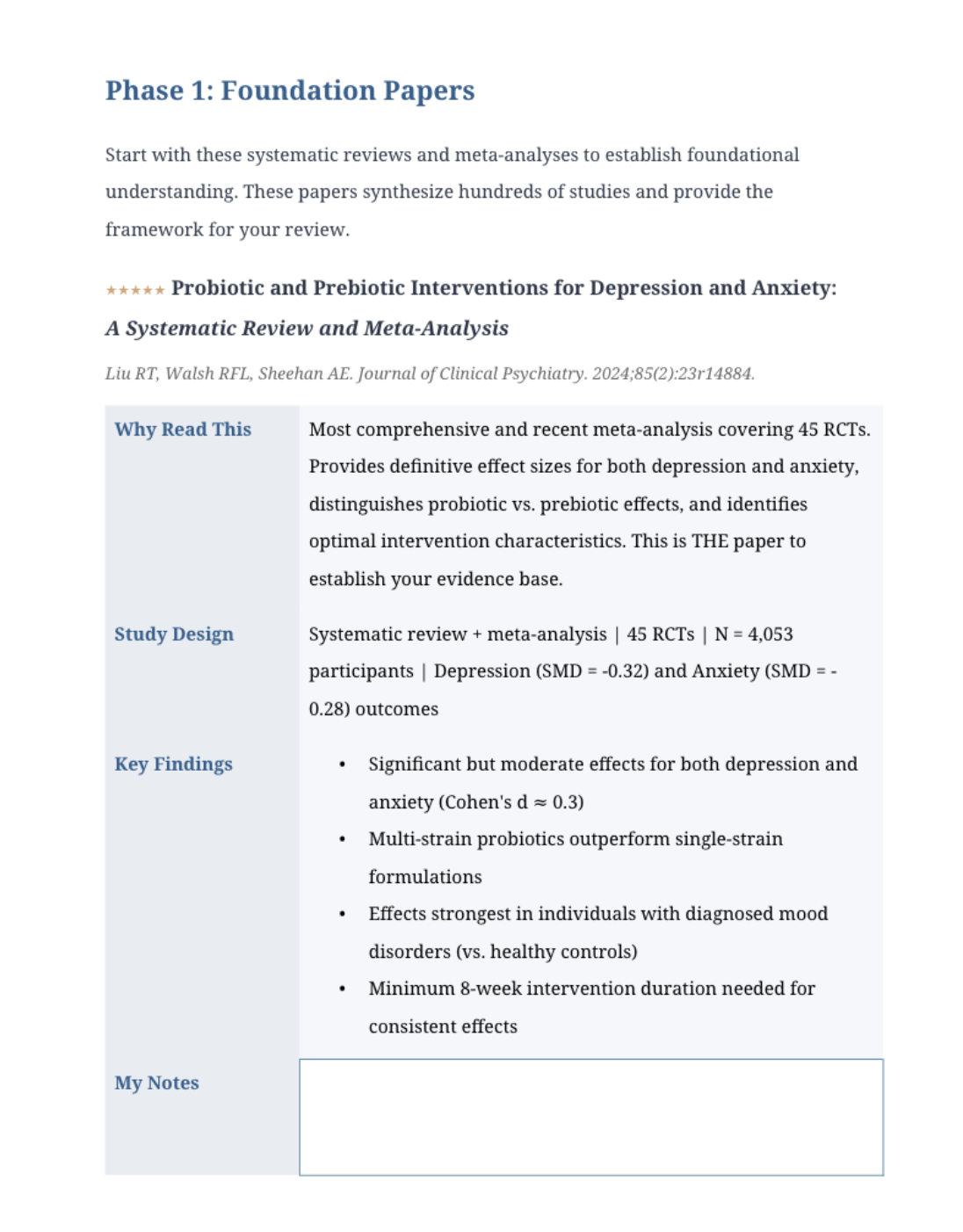- CategoryResearch
- ModelSonnet 4.5
- Features
- ShareCopy link
Describe the task
Thorough literature reviews require reading hundreds of papers to identify the dozen that matter. Claude accelerates this process by systematically searching databases, evaluating relevance against your specific research questions, and organizing findings so you can focus on synthesis and original analysis rather than mechanical sorting.
Tell Claude your research question. Claude searches the database for relevant papers, helps you identify which ones are most important to read, then organizes findings as you upload and work through each paper.
I'm beginning a literature review on the gut-brain axis and its role in mood disorders, specifically depression and anxiety. I need to understand:
- Mechanisms linking gut microbiome changes to mood regulation
- Evidence for probiotic interventions in clinical trials
- The role of inflammation and neurotransmitter production
Search PubMed for the most relevant papers from the last 5 years and create a structured reading guide that helps me prioritize what to read first.
Organize everything into a beautifully designed Word document that serves as my research roadmap—something that feels like a premium research tool with clear visual hierarchy, color-coding by study type, and space for my notes as I work through the papers.
Give Claude context
Connect Claude to relevant research tools and enable the specific features that make this workflow powerful.
Required context
Connect PubMed to allow Claude to search the full PubMed database, not just work with papers you already have.




Optional context
Turn on Extended Thinking so Claude can spend more time evaluating research and creating high-quality outputs.
What Claude creates
Claude researches PubMed’s database to find relevant papers and creates guide to help you through your entire research process—from initial discovery through final synthesis.
I've created a comprehensive research roadmap for your literature review on the gut-brain axis and mood disorders. I searched PubMed and curated 42 high-impact papers—12 systematic reviews, 18 RCTs, and 12 mechanistic studies—organizing them into a strategic three-phase reading plan.
Phase 1: Foundation Papers (Week 1) are the high-impact systematic reviews and meta-analyses that establish foundational understanding. These papers synthesize hundreds of studies and provide the theoretical framework for your review.
Phase 2: Mechanism & Evidence (Weeks 2-3) includes the mechanistic studies explaining how the gut-brain axis works, plus the strongest clinical trials showing intervention effects.
Phase 3: Gap Analysis (Week 4) covers emerging research and contradictory findings that will strengthen your critical analysis.
The document includes a visual landscape overview showing how papers distribute across study types, detailed profiles for each priority paper with relevance ratings and key findings, and space for your notes throughout. I've color-coded the categories and designed it as a professional research tool you can use throughout your review process.
View your research roadmap
Follow up prompts
Validate a claim you develop
Test whether patterns you notice actually hold across your full dataset. Claude analyzes whether trends are real or coincidental and identifies exceptions or contradictions.
I want to say most recent studies focus on X while older ones focused on Y. Does this hold across these papers, or are there contradictions? Help me understand why or why not, and flag any papers that contradict this pattern.
Understand contradicting sources
When you notice sources conflict, Claude can help investigate why and search for additional sources that might help you understand and resolve the discrepancy.
Paper A claims [finding] while Paper B claims the opposite. Analyze why they contradict and search for other papers that might resolve or explain this contradiction.
Search for missing coverage
If you spot gaps of knowledge as you read, ask Claude to search for relevant sources to try to fill them and show where new findings might fit into your research.
I'm seeing a gap in my coverage of [specific mechanism/population/intervention]. Search PubMed for papers specifically addressing this, evaluate them, and add the most relevant ones to my roadmap. Where do they fit in my reading sequence?
Tricks, tips, and troubleshooting
Always verify critical citations
Claude is excellent at tracking evidence, but double-check any quote that's central to your argument against the original paper before submitting your work. Use Claude to help you find the relevant passages quickly, but verify the exact wording yourself.
Open the actual file, not just the preview
Claude's in-chat previews show basic structure, but the actual Word document contains full formatting, color-coding, and design elements that don't appear in previews. Download and open the file to see the true form and make edits.
Expand your research infrastructure
Connect the Google Drive integration so Claude can search your existing collection, identify papers you've already read, and organize new findings alongside your current library—no manual uploading required. For databases beyond PubMed, check the directory for more connectors.
Use design language for better outputs
The prompt includes design language throughout, with phrases like ‘beautiful designed”, “professional formatting”, and “premium research tool”. Without design cues, Claude opts towards its default formatting. With specific prompting, Claude can apply unique typography, color, and formatting choices.
Ready to try for yourself?
